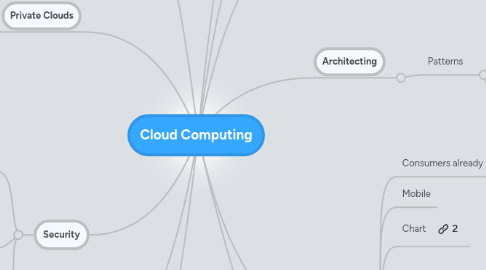
1. Benefits
1.1. CAPEX moves to OPEX
1.2. Enables layers
1.2.1. HaaS
1.2.2. IaaS
1.2.3. PaaS
1.2.4. SaaS
1.3. Economies of Scale
2. Private Clouds
2.1. Reasons
2.1.1. Need to control data
2.1.2. Availability control
2.1.3. User community control
2.1.4. Relatively high economy of scale
2.2. Disadvantages
2.2.1. Loses economy of scale found in public cloud
2.2.2. Better security unlikely
2.3. Has all principles besides 2
2.3.1. Pooled resources
2.3.2. Metered Billing
2.4. Deployment Options
2.4.1. Eucalyptus
2.4.2. OpenNebula
2.4.3. Ubuntu 9.10 server has Ubuntu enterprise cloud (UEC) option (uses Eucalyptus)
2.4.4. Xen (used by Eucalyptus) is compatible with Amazon
2.5. Examples
2.5.1. Apps.gov
3. Security
3.1. Has historically slowed cloud adoption
3.2. Modern data center security
3.2.1. Physical security
3.2.2. Access security
3.2.2.1. Key Pairs
3.2.2.2. Tokens
3.2.2.3. Hosting OS locked tight
3.3. SAS 70 Certifications
4. Testing
4.1. Selenium
4.2. Litmus
4.3. jmeter
4.4. loadrunner
5. Current State
5.1. 500,000 Companies on Amazon AWS
5.2. Example Providers
5.2.1. Amazon
5.2.2. Google
5.2.3. Rackspace
6. ■ Application frameworks will have a significant role in the growth and evolution of cloud computing. ■ The second or middle (application logic) tier and the third tier (storage) will more often run in the cloud. ■ Rapid evolution will occur for different storage mechanisms, particularly for unstructured data and database scaling strategies such as sharding. ■ Security services will include more and stronger options to protect sensitive data. ■ Over the next decade, companies with valuable data repositories will offer higher-level services hosted on existing clouds, each with a unique API. ■ Adoption and growth of mashups will fuel the further growth of the cloud. ■ What most call PaaS (for example, Google’s App Engine) and its natural extension—Framework as a Service—will become the predominant way applica- tions are constructed in 10 years. ■ More powerful development tools will quickly evolve to make it easy to build mashups. ■ Developers outside the U.S. and Europe will leapfrog the West because they’re not encumbered by legacy IT infrastructure. ■ The cost of creating an application will become so low that it will cease to be a barrier.
7. Main Principles
7.1. Pooled Resources - available to any subscribing user
7.2. Virtualization
7.3. Elasticity - dynamic scale without CAPEX
7.4. Automation - build, deploy, configure, provision, and move without manual intervention
7.5. Metered Billing
8. Data Centers
8.1. Traditional large data center is $100-200 million
8.2. Mega data centers at $500 million
8.3. Becoming more efficient and flexible through modularity
8.4. Virtualization
8.4.1. Allows for higher efficiency rating
9. Where it doesn't make sense
9.1. Legacy systems
9.2. Real-time or mission critical
9.3. Confidential data
10. Architecting
10.1. Patterns
10.1.1. Internet scale
10.1.1.1. Sharding
10.1.1.1.1. Denormalized
10.1.1.1.2. Parallel
10.1.1.1.3. Partitioning
10.1.2. Burst computing
10.1.3. Elastic Storage
10.1.4. Transference - ability to move application as-is
11. Future
11.1. Consumers already fully on board
11.2. Mobile
11.3. Chart
11.4. 10 Predictions
11.4.1. ■ The cloud will be cheaper, more reliable, more secure, and easier to use. ■ The cloud will become a real engine of growth for early adopter companies. ■ Cloud providers’ costs will be less than 25% of what corporate data centers cost. ■ Cloud mega-data centers will contain 500,000 servers costing $1B by 2020. ■ The best cloud provider operator’s ratio of administrators to servers will go from 1:1,000 servers to 1:10,000 servers by 2020. ■ Open source will dominate the future of the cloud. ■ Pragmatic standards come from market leaders; Amazon’s API will lead the way. ■ An ultimate ISO cloud standard will emerge. ■ Government will lead enterprises in cloud adoption. ■ SaaS will grow and stay current by using the basic web standards that will them- selves continue to advance.
